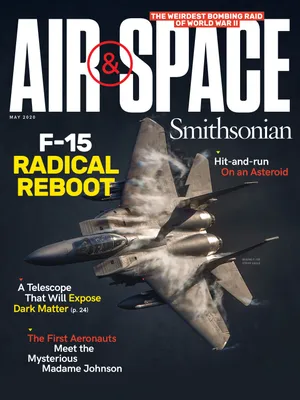How Do You Move a Six-Story Space Mural?
Slowly, one panel at a time.
/https://tf-cmsv2-smithsonianmag-media.s3.amazonaws.com/filer/fe/c7/fec7ab24-21b2-4c87-95a8-f471ae37c5ab/16b_am2020_mccallbmurals_48607341283_3cf38ee66f_o_live.jpg)
Crowds filled the sidewalk in January 1976, peering through the building’s glass walls and doors in hopes of glimpsing the treasures within. And even though the Smithsonian’s new National Air and Space Museum wouldn’t officially open until July 1, former astronaut and Museum director Michael Collins made a decision. He would open the Independence Avenue doors from 10 a.m. to 5:30 p.m. each day, and allow visitors to approach a temporary barrier within the Museum lobby and look around.
The intense curiosity was sparked, in part, by two artists, each working high on scaffolding, painting murals of gigantic proportions. One depicted aviation, the other, space.
The murals weren’t painted directly onto the Museum’s walls, but onto Belgian linen bonded to the wall’s surface—something that came in handy just recently, when the massive artworks were removed and placed in storage while the Museum undergoes a multi-year restoration. (Much of the Museum will remain open during construction.)
The artists were Robert McCall (Space Mural: A Cosmic View), and Eric Sloane (Earth Flight Environment). Their murals are immense: A Cosmic View, for instance, measures 75 feet tall by nearly 59 feet wide. “I knew they would be used to painting on something like canvas rather than drywall,” says James Dean, who was curator of art at the Museum when the Mall location opened in 1976. “I hired wallpaper hangers to put the material up on the wall,” says Dean.
After the linen was coated with gesso (a primer), the artists’ assistants marked off the mural areas in one-foot squares. The preliminary sketches submitted to the Museum by each artist were then marked off in one-inch squares, “so [the artists] could really track the whole thing across the giant walls from the mockups they’d done in small-scale,” says Dean.
“Sloane had written and illustrated several books about the weather and flying, so he was a natural choice to paint the aviation side,” says Dean. “During his breaks from painting the mural, he would play an accordion for his assistant.” And McCall had worked under Dean as a NASA artist; “I can’t think of a part of the space program that he didn’t get involved in,” says Dean. “NASA admired his work because they never had to worry about the accuracy; he knew his subjects really well. And that was my experience with him on the mural.”
The lobby murals remained in place for nearly 45 years; they were taken down in late 2019, over a period of weeks. “They were removed in 10-foot widths,” says conservation head Malcolm Collum. “The crews have a scaffolding tower,” he says, “and they start at the top and work their way down.” They used spatulas and blades to separate the linen from an adhesive that held it to the wall. As the pieces came down, the workers rolled them onto a tube, face-in. Once a piece of mural is removed from the wall, the back is cleared of any remaining adhesive residue, and the mural sections are re-rolled in a face-out orientation, which is less stressful to the paint.
The Independence Avenue lobby will reopen in early 2022, and the murals will be reinstalled in their original locations, ready to welcome visitors and serve once again as an iconic background in millions of photos.
